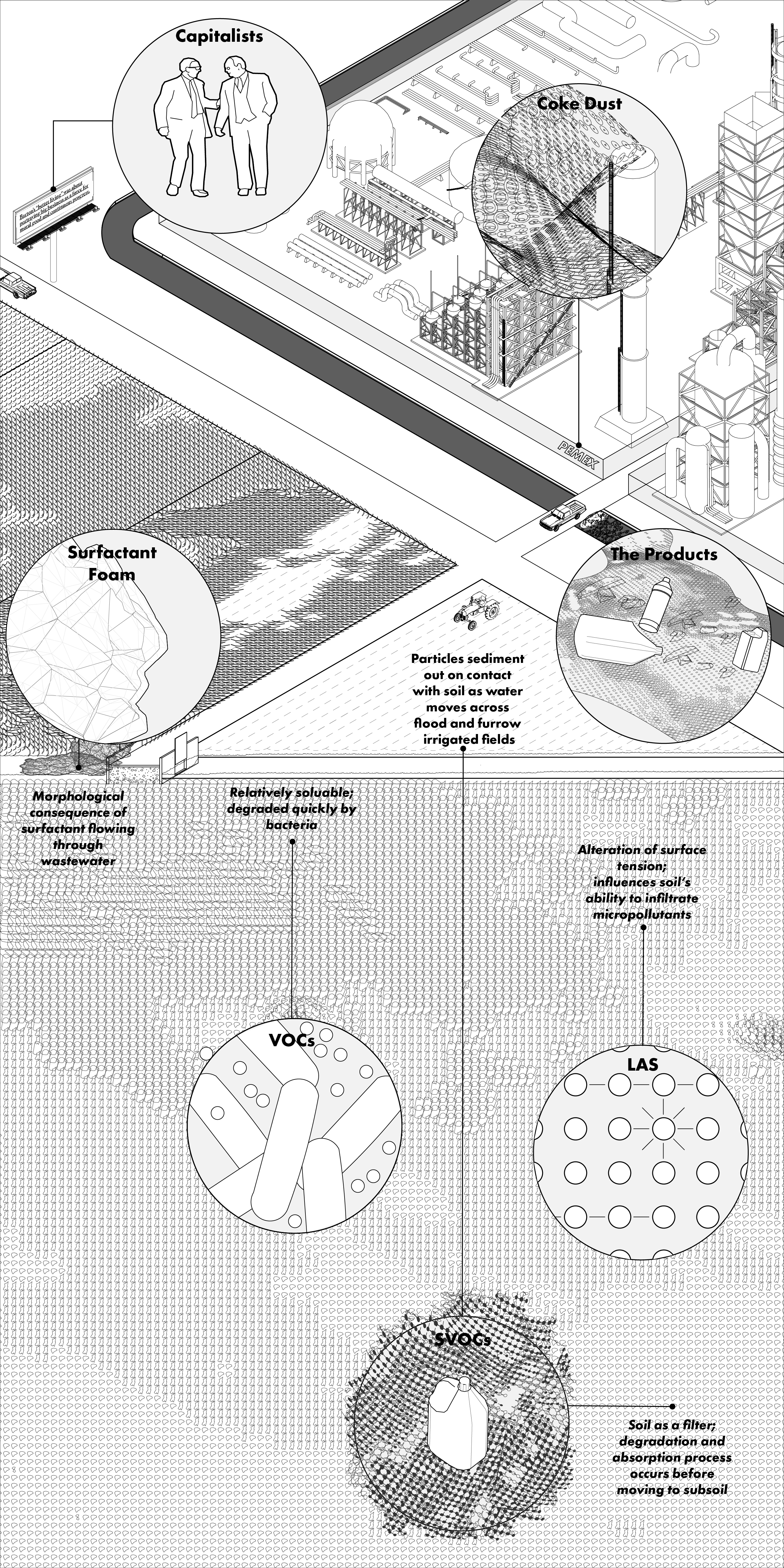
Brittany Giunchigliani (MLA I ‘21) & Charles Burke (MArch I + MDes HPDM ‘21)
Tracing the flow of industrial effluents through a series of infrastructural canals is no small task. Research on the distribution, accumulation, infiltration, and deposition of industrial effluents in the Mezquital is fragmented, making it difficult to compose a complete picture of the journey that a byproduct makes as it leaves the home, the textile factory, the storm drain, or the gas station. Therefore, we took a different approach. Rather than tracing the phthalates, volatile compounds, and surfactants merely through their interaction with water, sediment, and soil, we found that these compounds must be traced through their relationship to the narrative and mechanical sources of the Mezquital’s pollution.
We must first clarify the form of the pollution at its inception: many of the characters we have chosen to highlight and appear in the landscapes and soil profiles above, have been drawn both as a container of and visual expression of their product. We found it essential to illustrate the importance of how these compounds transform along the journey from the factory in Mexico City, along the lined and unlined canals, and into the soils of the Mezquital. From factory to field, their form is altered both passively and actively as they come in contact with different materials, surfaces, sediments, and other pollutants. Each character has been defined through their cultural, historical, political, and morphological relationship to the formation of soil and what we will now conceive as narrative effluent.
As mentioned, the industrial byproducts that make their way from Mexico City to the Mezquital most often begin as a container. The compounds that are discarded as a result of the production of industrial goods and services enter into the wastewater and migrate to the Mezquital through a series of lined and unlined canals before entering the soil. To conceptualize the journey from product to compound to water to soil, we rely on metonyms to produce a narrative structure of each phase. These narrative effluents include the byproducts of Mexico’s robust advertising sector, as well as products of political and capitalist rhetoric that consumed Mexico after the introduction of NAFTA - an agreement among three major stakeholders (USA, Canada, and Mexico) that significantly altered Mexico’s relationship to capitalism, globalization, and industrialization. We also include the mechanical artifacts which embody this capitalist distribution and production: including billboards, industrial washing machines, and cars.
Source: Jstor Daily
Tula Refinery, Sluice Gate, Oil Slick, Surfactant Foam, Petroleum Coke Dust

This particular type of soil formation cycles back in as a political narrative that takes the form of positive publicity from the stakeholders of the products that pollute the Mezquital. The cycle continues - publicity, production, consumption, disposal. The accumulation of these narrative effluents is the main focus of our analysis on soil formation in the Mezquital and how to better understand how the “other side of the pipe” influences the humans and nonhumans that live with these effluents.
Our landscapes above reflect the connection between factory and field, and also emphasize that industry does not only appear on the ‘Mexico City side of the pipe’.
In the Mezquital, for example, the state-owned Tula Refinery plays a major role in the production of crude oil and gas for Mexico and is a prominent figure in the landscape of the Mezquital. Its network of hidden, often punctured pipes and monumental size contains the product that fuels an important industry in Mexico. This industry has its own stream of narrative effluents that oscillate between product and fluid, publicity and pollution, and travel between Mexico City and the Mezquital through a complex web of culture, politics, history, and morphology.
In conclusion, the specificity of academic and scientific research must be coupled with an analysis of the narrative elements which play a significant role in the formation of industrial effluents as they make their way into our water and soil. By looking first at the cultural, ideological, and economic representations of the top industries in Mexico, we are able to mine metonymic elements which represent ‘each phase of the pipe.’ This method produces a study of the Mezquital and its soil which resists being categorized as a linear pathway of causal relationships, but is rather more recognizable as a cycle, from factory to field to farmer, and back again.